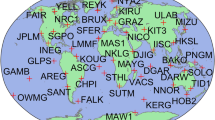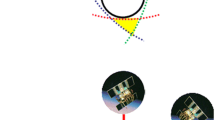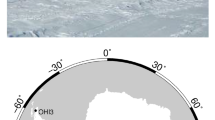Abstract
We extend the application of real-time kinematic PPP to aerial triangulation using GPS to determine coordinates of the antenna installed on the airplane, using real-time satellite products from IGS and the CNES Analysis Center. In order to verify the performance of real-time kinematic PPP for aerial triangulation, three tests with varying aerial and ground conditions are assessed. Numerical results show that real-time kinematic PPP using IGS real-time products of 5-cm orbit accuracy and 0.1- to 0.3-ns clock precision can provide comparable accuracy for aerial photogrammetric mapping at the scale of 1:1000 as does post-mission kinematic PPP using IGS final products. Millimeter-to-centimeter-level differences and centimeter-to-2-decimeter differences are identified for horizontal and vertical coordinates of ground check points, respectively, in the three tests. The comparison between real-time IGS and CNES products for GPS positioning and aerial triangulation unveils that real-time products with a better clock precision can result in better performance of GPS real-time kinematic PPP as applied to aerial triangulation.







Similar content being viewed by others
References
Ackermann F (1984) Utilization of navigation data for aerial triangulation. Int Arch Photogramm Rem Sens 25(Part A3a):1–9
Ackermann F (1994) Practical experience with GPS supported aerial triangulation. Photogramm Rec 14(84):861–874
Boehm J, Niell A, Tregoning P, Schuh H (2006) Global Mapping Function (GMF): a new empirical mapping function based on numerical weather model data. Geophys Res Lett 33:L07304
Boehm J, Heinkelmann R, Schuh H (2007) Short note: a global model of pressure and temperature for geodetic applications. J Geod 81(10):679–683
Chen B, Liu Z (2014) Voxel-optimized regional water vapor tomography and comparison with radiosonde and numerical weather model. J Geod 88(7):691–703
Dousa J, Vaclavovic P (2014) Real-time zenith tropospheric delays in support of numerical weather prediction applications. Adv Space Res 53(9):1347–1358
Friess P (1986) A simulation study on the improvement of aerial triangulation by navigation data. Int Arch Photogramm Rem Sens 26(3):269–283
Gao Y, Chen K (2004) Performance analysis of precise point positioning using real-time orbit and clock products. J GPS 3(1–2):95–100
GB/T 7930-2008 (2008) 1:500, 1:1000, 1:2000 Topographical Maps Specifications for Aerophotogrammetric Office Operation. Standards Press of China, Beijing, China (in Chinese)
Geng J, Bock Y, Melgar D, Crowel B, Haase J (2013) A new seismogeodetic approach applied to GPS and accelerometer observations of the 2012 Brawley seismic swarm: implications for earthquake early warning. Geochem Geophys Geosyst 14:2124–2142
Hadas T, Bosy J (2015) IGS RTS precise orbits and clocks verification and quality degradation over time. GPS Solut 19(1):93–105
Kouba J (2009) A guide to using International GNSS Service (IGS) products. http://acc.igs.org/UsingIGSProductsVer21.pdf
Lucas R (1987) Aerotriangulation without ground control. Photogrammetric Engineering & Remote Sensing 53(3):311–314
Petit G, Luzum B (2010) IERS Conventions 2010. http://www.iers.org
RTCM Special Committee 104 (2011) Differential GNSS (Global Navigation Satellite Systems) Services - Version 3+ Amendments 1, 2, 3, 4, and 5 to RTCM 10403.1. https://ssl29.pair.com/dmarkle/puborder.php?show=3
Saastamoinen J (1972) Contributions to the theory of atmospheric refraction. Bull Géod 105:13–34
Schmid R, Steigenberger P, Gendt G, Ge M, Rothacher M (2007) Generation of a consistent absolute phase-center correction model for GPS receiver and satellite antennas. J Geod 81(12):781–798
Shi J, Xu C, Guo J, Gao Y (2014) Local troposphere augmentation for real-time precise point positioning. Earth Planets Space 66:30
Shi J, Xu C, Guo J, Gao Y (2015a) Real-time GPS precise point positioning-based precipitable water vapor estimation for rainfall monitoring and forecasting. IEEE Trans Geosci Rem Sens 53(6):3452–3459
Shi J, Xu C, Li Y, Gao Y (2015b) Impacts of real-time satellite clock errors on GPS precise point positioning-based troposphere zenith delay estimation. J Geod 89(8):747–756
Wright T, HouliéN Hildyard M, Iwabuchi T (2012) Real-time, reliable magnitudes for large earthquakes from 1 Hz GPS precise point positioning: the 2011 Tohoku-Oki (Japan) earthquake. Geophys Res Lett 39:L12302
Wu J, Wu S, Hajj G, Bertiger W, Lichten S (1993) Effects of antenna orientation on GPS carrier phase. Manuscr Geod 18:91–98
Yuan X (2008) A novel method of systematic error compensation for a position and orientation system. Prog Nat Sci 18(8):953–963
Yuan X, Fu J, Sun H, Charles T (2009) The application of GPS precise point positioning technology in aerial triangulation. ISPRS J Photogramm Rem Sens 64:541–550
Zhang X, Forsberg R (2007) Assessment of long-range GPS kinematic positioning errors by comparison of airborne laser and satellite altimetry. J Geod 81(3):201–212
Zumberge J, Heflin M, Jefferson D, Watkins M, Webb F (1997) PPP for the efficient and robust analysis of GPS data from large networks. J Geophys Res 102:5005–5017
Acknowledgments
IGS and CNES are acknowledged for providing the post-mission and real-time satellite precise orbit and clock products. This work has been supported by the National Key Developing Program for Basic Sciences of China (Grant No. 2012CB719902) and National Natural Science Foundation of China (Grant Nos. 41371432, 41504027).
Author information
Authors and Affiliations
Corresponding author
Rights and permissions
About this article
Cite this article
Shi, J., Yuan, X., Cai, Y. et al. GPS real-time precise point positioning for aerial triangulation. GPS Solut 21, 405–414 (2017). https://doi.org/10.1007/s10291-016-0532-2
Received:
Accepted:
Published:
Issue Date:
DOI: https://doi.org/10.1007/s10291-016-0532-2




